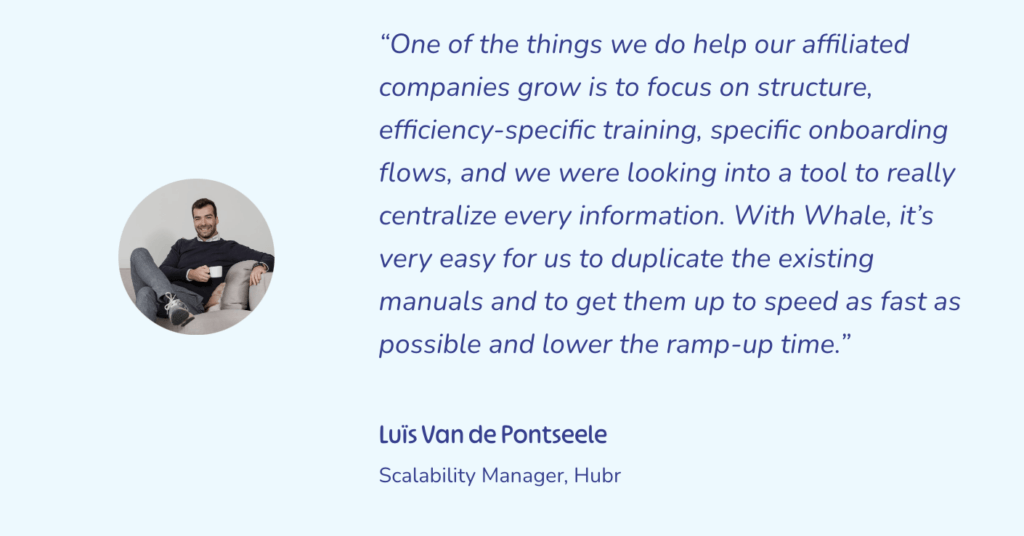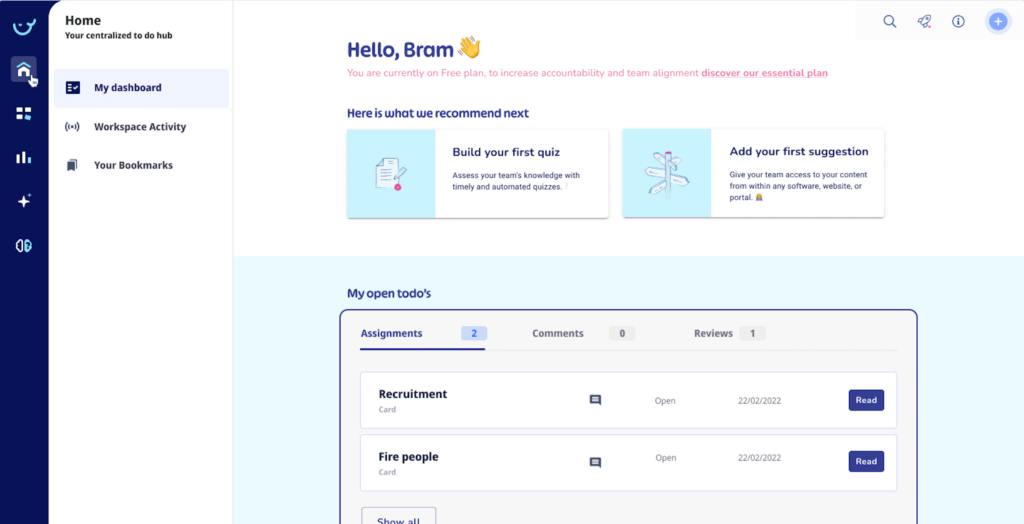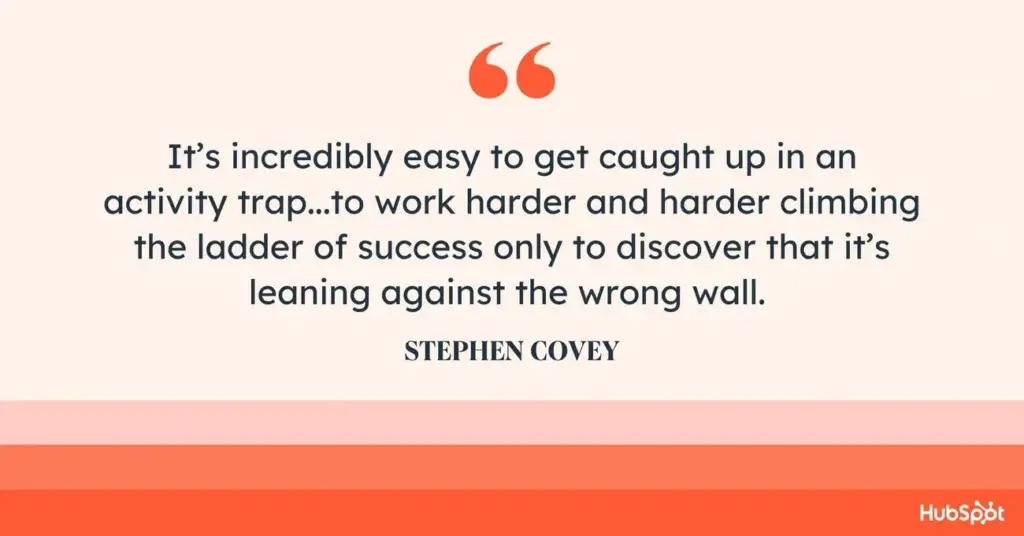Who’s got time to worry about an employee training strategy when you’re trying to scale your business right?
Well, the thing is that if set up right, your employee training strategy is one of the key elements that’s going to have your team performing at the top level!
Why you need an Employee Training Strategy?
63% of employees cite no opportunities for advancement as the top reason they quit. (Great Place to Work)
Effective employee training can;
- Act as a talent retention strategy
- elevate your businesses ease and efficiency of operations,
- Improve and promote productivity
- foster mutual respect among employees,
- Enhance customer service
- and cultivate a friendly workplace atmosphere.
We recently spoke to Luïs Van de Pontseele, the Scalability Manager at Hubr, who has the task of helping the company grow to 60 real estate agencies with 300 people within 5 years.
He quickly recognized that they employee training strategy in order to reach their growth objectives.

To harness these benefits, your training must be effective, adaptive, and tailored to your specific needs.
In this article, we’ll delve into what constitutes an employee training strategy and how to construct a comprehensive and successful plan.
What is a Training Strategy?
A training strategy is a structured approach designed to accomplish specific educational goals within a business. These goals can range from equipping employees with new skills to updating their knowledge in alignment with the company’s evolving goals and processes.
A well-crafted training strategy not only empowers your workforce but also serves the best interests of both employees and employers.
5 ways to make your Employee Training Strategy work
If you haven’t ever heard of the 70:20:10 approach to training, it is a model for learning and development. It states that;
- 70% of learning comes from experience, experiment and reflection,
- 20% derives from working with others
- And 10% comes from formal interventions and planned learning solutions.
The thing is that it’s a general guide. It’s important to remember that everyone learns in their own way and that each business requires a unique approach.
It does, however, point to the fact that most learning happens ‘in the flow of work’ as opposed to outside of it or in hypothetical situations.
It’s important to keep this in mind when developing your training strategy.
Step 1: Determine what's needed by identifying objectives
You can get super complicated by delving into a learning assessment but the most important things to understand are:
- What are the objectives of the company?
- What skills does the company need?
- What skills does the individual need to perform?
- What skills will the individual need in the future?
Be sure to get feedback from your team in the process and get them onboard.
Identify the gap between employees’ current skills and what’s required to achieve these objectives. Tailor your training activities to bridge this gap, considering the unique characteristics of your workforce.
Conducting a SWOT analysis
You could also conduct a SWOT (Strengths, Weaknesses, Opportunities, Threats) analysis to identify areas where your organization excels and areas needing improvement. Focus on strengthening your organization’s strengths, addressing its weaknesses, capitalizing on opportunities, and preparing for potential threats to enhance efficiency and productivity.
Mind the gap
Are there questions often asked by customers or even by team members that you often have to answer? By keeping track of these (yes, Whale does this), you’ll be able to see what needs to be addressed regarding process development and training.
It’s important to understand what’s needed practically and deliver that.
Step 2: Define Learning Objectives
Like anything, you’ve got to begin with the end in mind in order to be successful. (Steven Covey and the 7 Habits of Highly Successful People)
Set clear learning objectives for your training program.
Learning objectives define what employees should be able to do after completing the training. Ensure these objectives are Specific, Measurable, Achievable, Relevant, and Time-bound (SMART).
Objectives can pertain to knowledge, skills, or attitude, and they serve as a guiding principle for your training initiative.
Step 3: Design and Develop Training Materials
Before diving into training development, create training materials tailored to your learning objectives.
At Whale, our primary advice to anyone is to create processes and use them to train your teams from the beginning, as they serve as the foundation of how your business works.
Use the Netflix Effect to make training material engaging by using rich media to create content that your team members love.
Worried that it’s just going to take too much time?
Start from scratch and get it done in seconds with tools like Whale’s AI Assist and screen recording tool.
Remember to design materials that cater to the unique learning needs of your employees, with a strong focus on aligning content with your training objectives.
Remember Luïs?
Here’s how he and the team Designed and Developed their training;
Step 4: Implement with Tech
Incorporate hands-on practice, break down content into digestible segments, maintain a logical sequence, and involve participants in the training process through real-life examples.
But how? If you have 5 people, you could possibly find a time when everyone is free and do this on a weekly basis but even that’s probably not going to work.
Use employee training technology to automate training flows and to make sure that training is personalized for each employee.
Step 5: Evaluate the Training
How do you ensure employee training effectiveness?
Use quizzes to measure immediate knowledge retention and use frequency of training to ensure you overcome the forgetting curve.
Over the long term, you’re going to want to conduct an annual assessment to ensure that your employee training strategy is delivering on the objectives set in the beginning.
Use data like company objectives and the SMART goals set along with feedback from team members to see how employee training is having an impact.
Bottom Line?
The cost of replacing an employee can range from 50% to 200% of their salary, depending on the position. And yet turnover Is Eminently Fixable with 52% of exiting staff saying that their manager could have done something to prevent their leaving.
On average, more than 50% of sales teams believed training was effective to reach desired outcomes. And organizations that invest in employee training experience 11% greater profitability over organizations that don’t. (Seizmic)
If that doesn’t convince you that creating an employee training strategy is going to help grow your business, how about the fact that change is happening at breakneck speed. Industries keep changing, and it’s crucial to keep up.
For businesses, staying relevant means staying innovative. Innovation isn’t just a buzzword; it’s the key to capturing markets and growing. New ideas and strategies don’t just make products better; they also boost efficiency and transform old ways of doing things. But to innovate, you need a team of creative thinkers driving your business forward.
And creative thinkers need learning to stay innovative.
Maybe it is time to rethink your employee training strategy. Let’s talk
FAQs on an employee training strategy
Who is responsible for the employee training strategy?
Depending on the business, there are 2 stakeholders involved in the employee training strategy;
- The hiring manager and
- HR or the training manager
Before conducting a strategy it’s important to do an analysis on the business needs as well as the employees goals, to ensure that training meets the growth needs of the business and it’s team members.
What are trends influencing workforce training strategies?
AI and the rapid pace of innovation in the workplace is impacting how employee training strategies are created and implemented.
Some of these trends include;
- Utilizing AI powered training software
- Creating personalized training journeys
- Ongoing employee training in micro learning format
- The ability to measure the impact of training on the business









